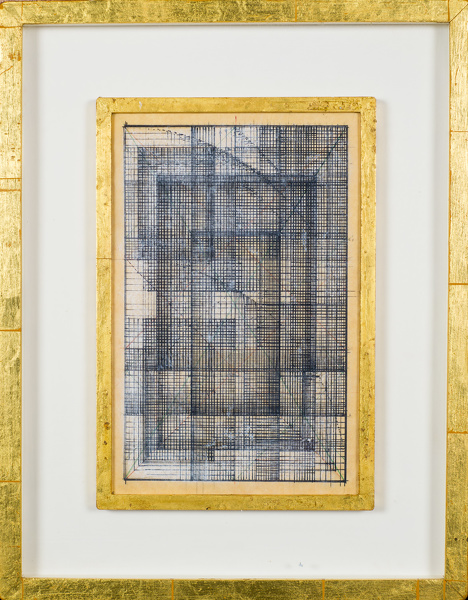
 SOLD
SOLD
Sir Thomas Monnington:
Study 3 for Reciprocity, c. 1970
Framed (ref: 6552)
Pen and ink and white chalk on tracing paper
8 1/4 x 5 1/4 in. (21 x 13.4 cm)
Framed approx. 13 1/4 x 10 1/4 in. (33.5 x 26 cm)
Tags: Sir Thomas Monnington chalk design ink pen and ink Canney Abstract Art Monnington
Provenance: The Artist's Family
About Reciprocity:
EXHIBITED: R.A 1971 (77); The Fine Art Society, 1997, (162)
Previewing this work in a newspaper interview (Tate archive, source and date not given) Monnington referred to this as only his second picture in two years.This he explained was on account of being “an extremely slow worker” and painting in “a rather old fashioned mixture of eggs, oil and water, which was used by the early Italian painters.”Asked what the finished painting would look like Monnington replied, “it will consist of a lot of squares”.The link that Monnington clearly made with the early Italian painters,not only through the pursuit of perfect proportion but technique demonstrates the underlying continuity in his work.There was no distinction in his mind between figurative and abstract art.“Surely what matters is not whether a work is abstract or representative, but whether it has merit.If those who visit exhibitions would come without preconceptions, would apply to art the elementary standards they apply in other spheres, they might glimpse new horizons.They might ask themselves: is this work distinguished or is it commonplace? Fresh and original or uninspired, derivative and dull?Is it modest or pretentious?( Interview in The Christian Science Monitor 29.5.67).

When the Tate purchased Monnington’s Square Design (1967) he spoke of his abstract paintings as “direct descendants from my ceiling painting in the Council House, Bristol, which was my first departure from purely representational painting. Since them I have been increasingly interested in the subdivisions of surface areas contained in equilateral rectangels (squares) and rectangles derived from square roots. These two-dimensional mathematical relationships suggest to me dimensions in depth, and provide a discipline which at the present time I find as necessary and interesting as that imposed previously in representational painting... You can cut out the blurb if you wish, but I was trying for my own edification to put into words what I think I have been trying to do in the last ten years”, (letter of 12th June 1968)
In a gilded frame set onto a white gesso board with gilded outer moulding, glazed.
This 'geometric' drawing dates to the early 1950's when Monnington was working on the ceiling design for the Bristol Council House. The New Bristol Council House, designed by Vincent Harris, was built in the early 1950s. Monnington was commissioned to paint the ceiling in 1953; it was unveiled in 1956. The ceiling, measuring 95 x 45 feet (over 4000 square feet), is amongst the largest post-war decorative schemes in Europe. Monnington insisted on painting in the Renaissance manner - directly onto wet plaster. The colours were ground and mixed with an emulsion of eggs, chalk and water - Bristol's Clerk of the Works delivered baskets of eggs daily.
'A suggestion by the Bristol city fathers that the subject should be "something connected with the Merchant Adventurers" fell on deaf ears. Monnington determined that his design should instead commemorate those scientific achievements which future Bristolians would associate with the mid-twentieth century, and which he himself had become excited by over the last twenty years: modern nuclear physics; electronics, which had enthralled him first in the shape of radio masts and later in radar equipment; aeronautics, whose laws he had begun to comprehend during the war; and biochemistry, where enlarged photographs of recent research revealed amazing quasi-abstract patterns.' Judy Egerton, Monnington, Royal Academy, 1977, p. 13.
Monnington's design bears similarities to the paintings of the Italian futurist Balla, but is underwritten by his deep admiration for Piero della Francesca, constructed as it is along the lines of the Golden Section. There are also stylistic similarities with the sculptures of Monnington's neighbour, Professor Gerrard. A number of drawings by Monnington for the ceiling are in the collection of the Victoria and Albert Museum, The Science Museum and Bristol City Art Gallery.
















